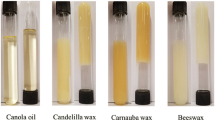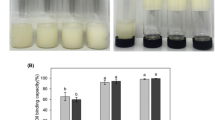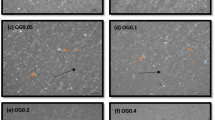Abstract
Two types of oleogels—made of carnauba wax with canola oil or beeswax with grapeseed oil—were prepared at concentrations from 0 to 15% (w/w) of wax. Physical characterization was done and oxidative stability of the oleogels were evaluated. As the proportion of wax increased from 5 to 15%, the enthalpy of crystallization and melting increased in both oleogels. The carnauba wax-based oleogel (CWO) required greater enthalpy than the beeswax-based oleogel (BWO). Differences in L*, a*, and b* values between control oils and the oleogels significantly decreased as the concentration of wax increased in the oleogels (5–15%; p<0.05). Oil-binding capacity of the BWO was higher than that of the CWO. Solid-fat content of the CWO did not change significantly from 10 to 60oC, whereas that of the BWO decreased. In general, oxidative stability of the CWO was better at 60 and 180oC heat treatment in comparison with control oils (p<0.05). However, the BWO did not provide high oxidative stability than the control oils.
Similar content being viewed by others
References
Stortz TA, Zetzl AK, Barbut S, Cattaruzza A, Marangoni AG. Edible oleogels in food products to help maximize health benefits and improve nutritional profiles. Lipid Tech. 24: 151–154 (2012)
Ögütcü M, Yilmaz E}. Oleogels of virgin olive oil with carnauba wax and monoglyceride as spreadable products. Grasas Aceites 65: 1–11 (2014)
Vintiloiu A, Leroux JC. Organogels and their use in drug delivery—a review. J. Control. Release 125: 179–192 (2008)
Dassanayake LSK, Kodali DR, Uedo S. Formation of oleogels based on edible lipid materials. Curr. Opin. Colloid In. 16: 432–439 (2011)
Hu FB, Stampfer MJ, Manson JE, Ascherio A, Colditz GA, Speizer FE, Hennekens CH, Willett WC. Dietary saturated fats and their food sources in relation to the risk of coronary heart disease in women. Am. J. Clin. Nutr. 70: 1001–1008 (1999)
Kim JY, Yi BR, Kim MJ, Lee JH. Oxidative stability of solid fats containing ethylcellulose determined based on the headspace oxygen content. Food Sci. Biotechnol. 23: 1779–1784 (2014)
Mozaffarian D, Katan MB, Ascherio A, Stampfer MJ, Willett WC. Trans fatty acids and cardiovascular disease. N. Engl. J. Med. 354: 1601–1613 (2006)
Co ED, Marangoni AG. Organogels: An alternative edible oil-structuring method. J. Am. Oil. Chem. Soc. 89: 749–780 (2012)
Botega DCZ, Marangoni AG, Smith AK, Goff HD. The potential application of rice bran wax oleogel to replace solid fat and enhance unsaturated fat content in ice cream. J. Food Sci. 78: C1334–C1339 (2013)
Patel AR, Dewettinck K. Edible oil structuring: An overview and recent updates. Food Funct. 7: 20–29 (2016)
Jang A, Bae W, Hwang HS, Lee HG, Lee S. Evaluation of canola oil oleogels with candelilla wax as an alternative to shortening in baked goods. Food Chem. 187: 525–529 (2015)
Saint-Germain M, Buddle CM, Drapeau P. Sampling saproxylic coleoptera: Scale issues and the importance of behavior. Environ. Entomol. 35: 478–487 (2006)
Villalobos-Hernández JR, Müller-Goymann CC. Novel nanoparticulate carrier system based on carnauba wax and decyl oleate for the dispersion of inorganic sunscreens in aqueous media. Eur. J. Pharm. Biopharm. 60: 113–122 (2005)
Chauzat MP, Faucon JP. Pesticide residues in beeswax samples collected from honey bee colonies (Apis mellifera L.) in France. Pest Manag. Sci. 63: 1100–1106 (2007)
Yilmaz F, Daðdemir E. The effects of beeswax coating on quality of Kashar cheese during ripening. Int. J. Food Sci. Tech. 47: 2582–2589 (2012)
Martins AJ, Cerqueira MA, Fasolin LH, Cunha RL, Vicente AA. Beeswax organogels: Influence of gelator concentration and oil type in the gelation process. Food Res. Int. 84: 170–179 (2016)
Jibry N, Sarwar T, Murdan S. Amphiphilogels as drug carriers: Effects of drug incorporation on the gel and on active drug. J. Pharm. Pharmacol. 58: 187–194 (2006)
Stortz TA, Marangoni AG. The replacement for petrolatum: Thixotropic ethylcellulose oleogels in triglyceride oils. Green Chem. 16: 3064–3070 (2014)
AOCS. Official Methods and recommended practices of the American Oil Chemists’ Society. 4th ed. Method Cd 16d-93, Ti 1a-64, Cd 18-90. AOCS Press, Champaign, IL, USA (1990)
Yilmaz E, Ögütcü M. Properties and stability of hazelnut oil organogels with beeswax and monoglyceride. J. Am. Oil Chem. Soc. 91: 1007–1017 (2014)
Yi BR, Ka HJ, Kim MJ, Lee JH. Effects of curcumin on the oxidative stability of oils depending on type of matrix, photosensitizers, and temperature. J. Am. Oil Chem. Soc. 92: 685–691 (2015)
Kim TS, Decker EA, Lee JH. Antioxidant capacities of a-tocopherol, trolox, ascorbic acid, and ascorbyl palmitate in riboflavin photosensitized oil-in-water emulsions. Food Chem. 133: 68–75 (2012).
Ögütcü M, Arifoglu N, Yilmaz E. Storage stability of cod liver oil organogels formed with beeswax and carnauba wax. Int. J. Food Sci. Tech. 50: 404–412 (2015)
Pieve SD, Calligaris S, Panozzo A, Arrighetti G, Nicoli MC. Effect of monoglyceride organogel structure on cod liver oil stability. Food Res. Int. 44: 2978–2983 (2011)
Author information
Authors and Affiliations
Corresponding author
Rights and permissions
About this article
Cite this article
Yi, B., Kim, MJ., Lee, S.Y. et al. Physicochemical properties and oxidative stability of oleogels made of carnauba wax with canola oil or beeswax with grapeseed oil. Food Sci Biotechnol 26, 79–87 (2017). https://doi.org/10.1007/s10068-017-0011-8
Received:
Revised:
Accepted:
Published:
Issue Date:
DOI: https://doi.org/10.1007/s10068-017-0011-8




